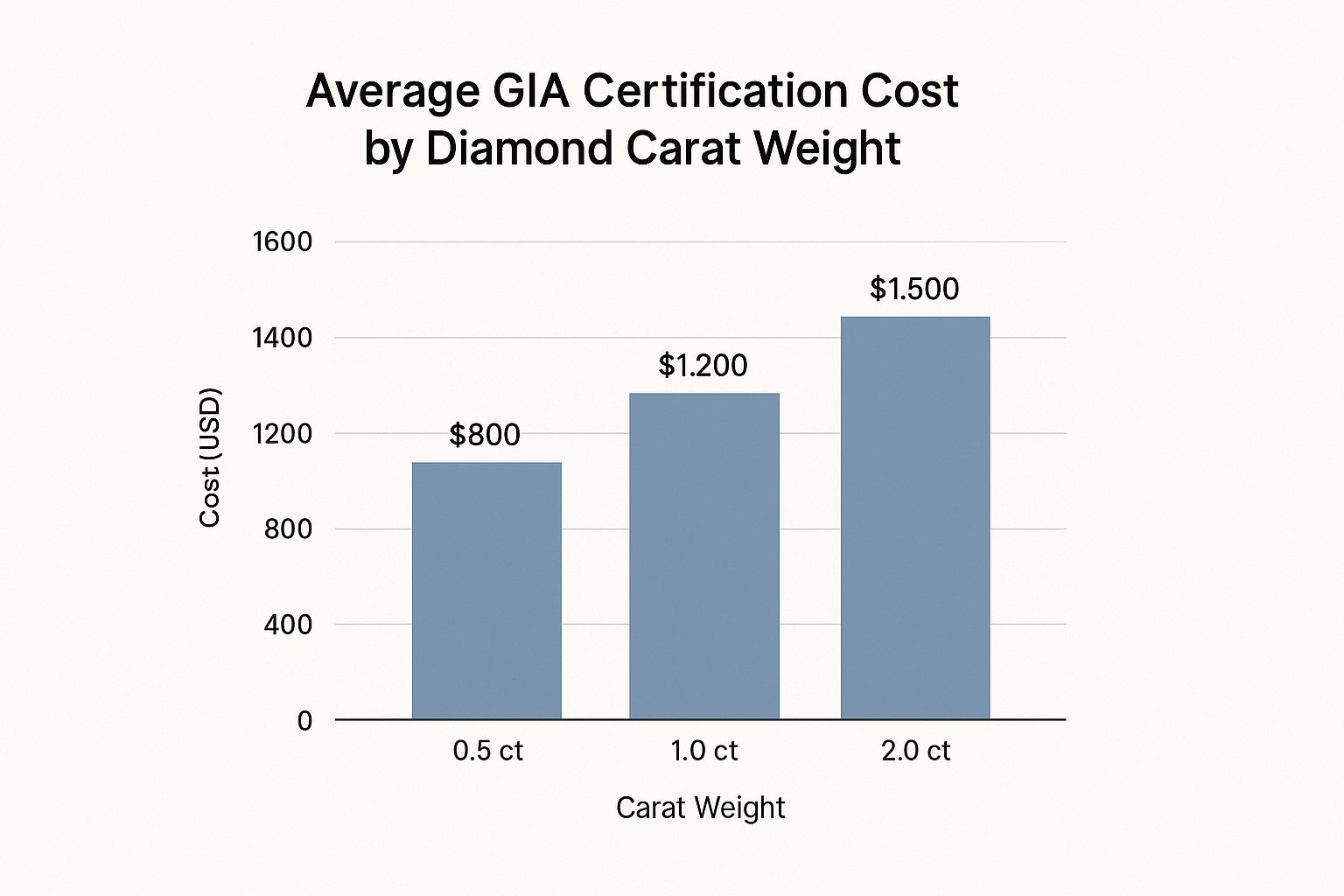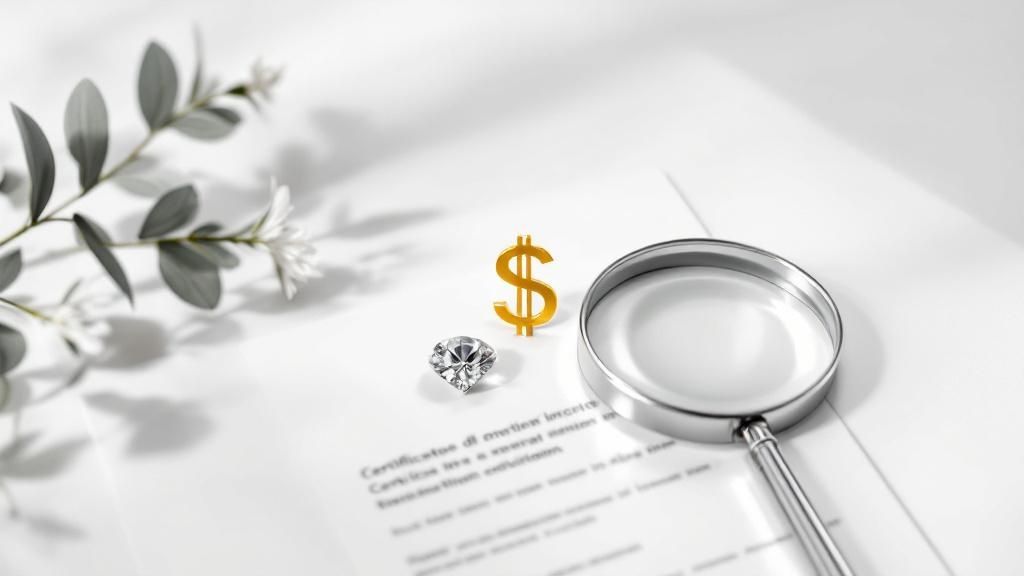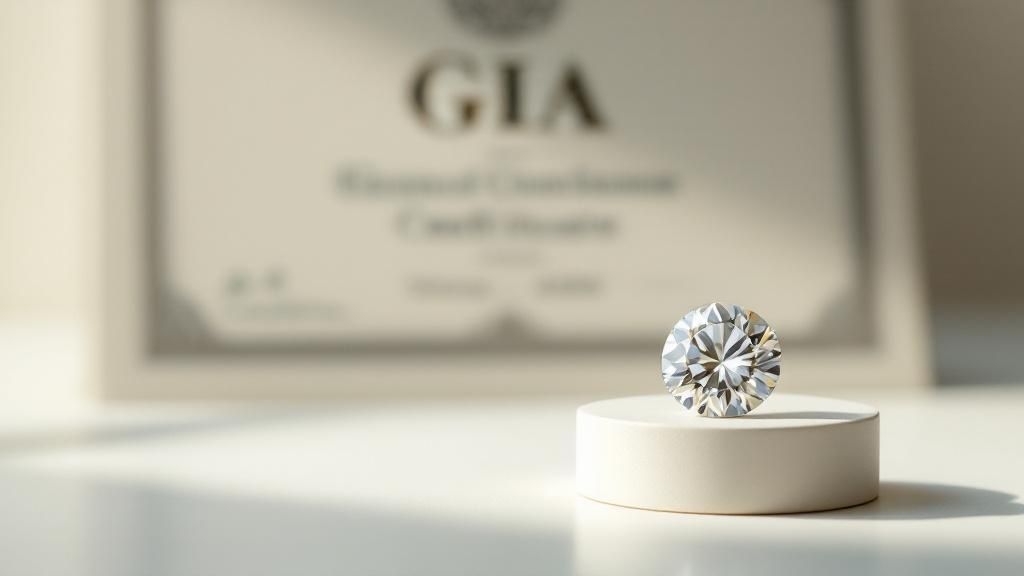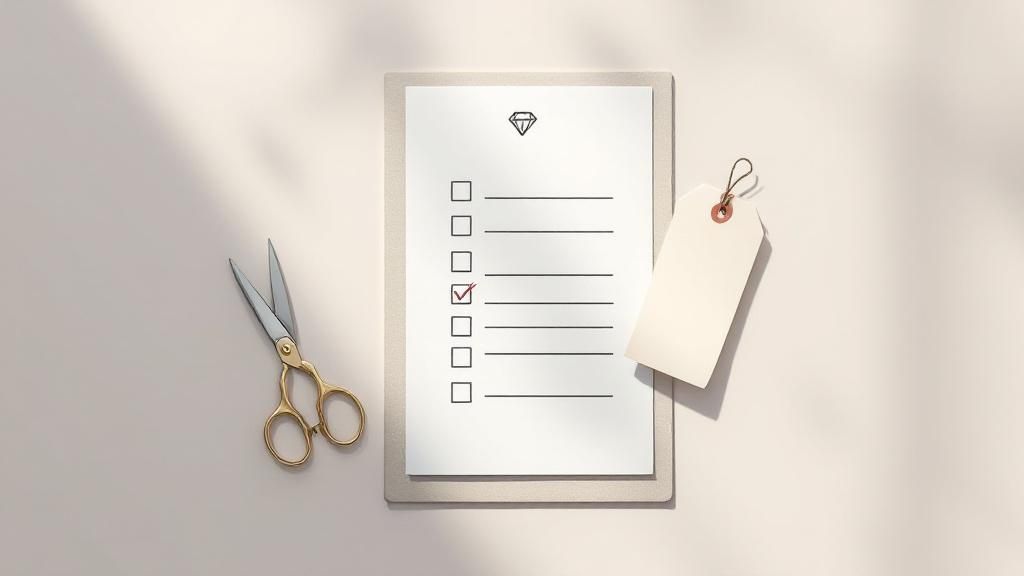Understanding GIA Certification Cost
- Luke Zucco
- Jul 26
- 9 min read
When you're looking at the GIA certification cost, you'll find there isn't one flat price. It’s a bit like insuring a valuable piece of art; the cost scales with the item's value and complexity. For a small diamond, you might start around $100, but that fee can climb into the hundreds for larger, more significant stones.
What Does a GIA Certificate Actually Cost?
So, how much are we really talking about? The Gemological Institute of America (GIA) uses a sliding scale for their fees, and the single biggest factor is the diamond's carat weight. This makes perfect sense when you think about it—the lab takes on more responsibility and needs to perform a more intensive analysis for a larger, more valuable diamond.
For a common one-carat round brilliant diamond, you can expect the GIA grading report to fall somewhere in the $110 to $160 range. If you jump up to a two-carat stone, that cost might be closer to $200 to $350. The price increases because the stakes are higher and the gemological assessment is more involved. For more perspectives on certification pricing, you can find some great information over at DiamondScreener.com.
Think of a GIA report not as a simple receipt, but as your diamond's official biography. The fee covers the unbiased, expert verification of its quality, which is what ultimately defines its true market value.
Estimated GIA Certification Fee by Diamond Weight
To give you a clearer idea of how this works in practice, let's look at some real-world numbers.
The table below provides a solid estimate of what you can expect to pay for GIA certification based on the carat weight of a standard round brilliant diamond. It really illustrates how the fees scale up.
Diamond Carat Weight | Estimated Cost Range (USD) |
|---|---|
0.50 - 0.99 ct | $80 - $120 |
1.00 - 1.49 ct | $110 - $160 |
1.50 - 1.99 ct | $150 - $250 |
2.00 - 2.99 ct | $200 - $350 |
As you can see, the price to certify a diamond climbs steadily with its weight. It's a direct reflection of the stone's increasing rarity and value.

The cost jumps are most noticeable as you cross those key carat-weight thresholds. This pricing structure mirrors the diamond market itself, where hitting that 1.00-carat or 2.00-carat mark significantly boosts a stone's value. Ultimately, the certification fee is a small, smart investment to protect the value of a much larger asset.
Why a GIA Report Is Your Diamond’s DNA Profile

Before we get into the numbers behind the GIA certification cost, let’s be clear about what a GIA report actually is. It's not just a fancy receipt or an appraisal of value. A much better way to think of it is as your diamond's unique DNA profile—a scientific and unchangeable record of its identity.
The GIA is a nonprofit, and their entire mission is built around protecting the consumer. This is a big deal. Because they have no financial stake in the sale of any diamond, their analysis is completely objective and trustworthy, which is why they've earned their reputation as the gold standard in the jewelry world.
What you get is a detailed, unbiased blueprint of your stone. The report meticulously documents the famous 4Cs, which serve as the universal language for diamond quality.
Decoding the 4Cs and More
At its heart, a GIA report gives you a definitive grade for each of the 4Cs, the very cornerstones of a diamond's value. These grades aren't just subjective opinions; they're the result of rigorous, standardized testing inside a controlled lab. If you want to go deeper, our guide on understanding diamond grades offers expert knowledge.
The report breaks down these core components:
Cut: This grade isn't about shape, but how well a diamond's facets play with light to create sparkle and brilliance.
Color: Measures the absence of color, on a scale from D (perfectly colorless) to Z (light yellow or brown).
Clarity: Assesses the presence of tiny internal features (inclusions) and surface characteristics (blemishes).
Carat Weight: The diamond's physical weight, measured with incredible precision.
A GIA report also details other critical factors like polish, symmetry, and fluorescence. It paints a complete picture that gives you undeniable proof of quality, which directly impacts your diamond’s value and verifies its authenticity.
Without this authoritative document, a diamond's quality is just a matter of opinion. The GIA certificate is what turns that opinion into a globally recognized fact.
The Key Factors Driving Your Certification Fee
While we’ve established that carat weight is the biggest piece of the puzzle, it’s not the only thing that determines your final GIA certification cost. Think of it like buying a car. The sticker price gets you the basic model, but the final cost climbs depending on the extras and upgrades you choose.
Your choice of GIA report is one of those major "upgrades." GIA offers a few different reports, and each one is built for specific needs and diamond sizes. For most natural, loose diamonds, you'll be deciding between two main options: the Diamond Grading Report and the Diamond Dossier®.
Report Type Matters
The GIA Diamond Grading Report is the full-service, comprehensive option. It gives you an in-depth assessment of the 4Cs (Cut, Color, Clarity, and Carat Weight) and, crucially, includes a plotted diagram. This diagram is like a unique fingerprint, mapping out every tiny inclusion and blemish on your diamond. Because of its detail, this report is typically for diamonds weighing 1.00 carat or more.
On the other hand, the GIA Diamond Dossier® is a more streamlined and budget-friendly report. It's designed specifically for diamonds in the 0.15 to 1.99 carat range. You still get the same expert grading of the 4Cs, but it doesn't include that detailed plot diagram. To make up for this, the Dossier service always comes with a microscopic laser inscription of the report number right on the diamond's girdle, making it easy to identify.
Optional Services Add Value and Security
Beyond the standard report, you can add a few optional services that will nudge the final fee. The most popular add-on by far is laser inscription. If you're getting a full Diamond Grading Report (which doesn't automatically include it), you can pay a little extra to have the report number etched onto the stone.
This inscription acts like a permanent license plate for your diamond. It provides an indisputable link between the physical stone and its official GIA report, offering an invaluable layer of security and peace of mind.
It’s important to remember these services are completely different from a jewelry appraisal, which focuses on assigning a market value rather than a scientific grade. To see how that process works, you can learn more about what a jewelry appraisal costs in our guide. Ultimately, every choice you make—from the report type to optional services—helps customize the GIA certification cost to fit your specific diamond and your need for security.
The Hidden Cost of Not Certifying a Diamond

It’s tempting to look at the GIA certification cost as just one more fee to tack onto your purchase. But that's looking at it from the wrong end. The real question you should be asking is: what’s the financial risk of buying or owning a diamond without a GIA report? Answering that question sheds a whole new light on the value of certification.
Let’s use an analogy. Would you ever buy a collector car without a title, service history, or even a VIN? I doubt it. Without that paperwork, you have zero proof of its authenticity or condition. You would rightly demand a massive discount to take on that kind of risk—if you'd even consider the purchase in the first place.
It's the exact same story with diamonds. An uncertified stone is a total gamble.
The Uncertainty Discount
In the diamond world, a stone without a GIA report sells at a significant markdown. It's not because the diamond is necessarily bad; it's because its quality is just someone's opinion, not a verified fact. A seller can tell you all day long that a stone is a G color with VS2 clarity, but without the impartial grading from GIA, those are just claims.
This creates a trust gap that hits the price tag—hard. Buyers simply aren't willing to pay top dollar for a mystery stone.
An uncertified diamond forces a buyer to price in the risk of the unknown. The "discount" they demand to compensate for that risk is almost always greater than the modest fee for a GIA report.
So, you see, you end up paying for certification one way or another. You can either pay the GIA fee upfront for an official, globally respected document that locks in your diamond's value. Or, you'll pay for it on the back end through a much lower resale price.
This hidden cost of skipping certification stings both buyers and sellers:
For Buyers: You're taking a huge risk of overpaying for a diamond that has been "grade-bumped" by a motivated seller. That stone they're calling an F/VVS2 might actually be an H/SI1. If so, you've lost thousands of dollars the second your credit card is charged.
For Sellers: When you eventually decide to sell, getting a fair price will be an uphill battle. Savvy buyers will be skeptical, and jewelers will make lowball offers to cover the risk and the cost they'll have to incur to get it certified themselves.
At the end of the day, the fee for a GIA report isn’t an expense. It's an investment in certainty. It’s your best protection against overpaying and your surest way to get the true value your diamond deserves. More often than not, that certificate pays for itself many times over.
How GIA Certification Protects Your Diamond’s Value
A GIA certificate isn't just a piece of paper that describes your diamond; it's what locks in its market value. Think of the GIA certification cost as an investment, not an expense. It’s what ensures your diamond is seen as a legitimate, tradable asset with a clearly defined quality. Without it, you're essentially asking a buyer to take your word for it, and in the diamond world, that's a risky bet.
Let's imagine you have two diamonds that look identical to the naked eye. One comes with a GIA report verifying its D color and VVS1 clarity. The other has no report, or maybe one from a lab known for being a bit generous with its grading. In any marketplace, the GIA-certified diamond will command a higher price every single time. Why? Because there’s zero doubt about its quality.
The Price Premium for Certainty
This isn't just a hunch; it's backed by hard market data. The authority of a GIA report creates what we call a price premium. When you compare diamonds with similar grades, GIA-certified stones sell for an average of 12% more than those certified by other labs like IGI. For larger or higher-quality gems, that difference can easily mean thousands of dollars. You can see this reflected in the price index research from Diamondse.info.
So, why does this premium exist? It’s simple: a GIA report eliminates risk for the buyer and creates liquidity for the seller. A jeweler or private buyer anywhere on the globe will instantly recognize and trust a GIA grade, making your diamond far easier to sell at a fair price.
The fee you pay for a GIA certificate is almost always returned to you, often many times over, through higher resale value and market confidence. It solidifies your diamond's standing as a tangible asset.
This is a critical concept for anyone who sees a diamond as more than just a beautiful object, but also as a store of value. The certificate is what turns a personal treasure into a liquid asset, which is a key factor when you're asking if jewelry is a good investment. Ultimately, that piece of paper proves you got exactly what you paid for.
Common Questions About GIA Certification

Even when you understand why a GIA report is so important, a few practical questions always pop up. It’s one thing to know the theory, but another to navigate the actual process. Let's tackle some of the most frequent questions I hear from clients.
One of the first things people wonder is if they can just mail their own diamond directly to GIA. The short answer is yes, you can. However, GIA is set up to primarily serve professionals in the jewelry trade. For an individual, this means creating a special account, navigating some pretty strict shipping rules, and making sure the diamond is securely transported both ways.
Honestly, it’s usually much simpler to go through a trusted jeweler. They already have established accounts and a smooth, routine process for submitting stones, which can save you a lot of hassle.
Timelines and Practical Considerations
Okay, so what about the wait? How long does it actually take to get a diamond graded? This can really vary. The turnaround time depends on how busy the GIA lab is, what specific services you’ve requested, and the diamond itself. As a general rule, it's wise to plan for at least three to four weeks from the day you ship it out to the day you get it back.
A GIA grading report never expires. The grades are based on the diamond's inherent, permanent characteristics. Of course, this only reflects the diamond's condition at the moment of grading—if it gets chipped or damaged later, that obviously isn't covered by the old report.
This brings up another fantastic question: is it really worth paying for GIA certification on a smaller diamond, like something under half a carat? This is where it gets a bit subjective.
For diamonds under 0.25 carats: The grading fee can feel disproportionately high compared to the stone's value. In most cases, it just doesn't make financial sense.
For diamonds between 0.25 and 0.50 carats: This is a judgment call. Having a GIA report definitely adds a layer of trust, but it might not significantly boost the resale value unless the diamond has an exceptionally high color and clarity grade.
For diamonds over 0.50 carats: At this point, I almost always recommend it. The certification cost is a small percentage of the diamond's overall worth, and the report provides critical proof of quality for your investment.
Knowing these practical details helps you decide when a GIA report moves from a "nice-to-have" to a "must-have," ensuring it truly adds value to your diamond.
At Panther De Luxe Shop, we believe in the power of knowledge and quality. Explore our curated collections, where every piece is selected with an expert eye for beauty and value. Visit our shop today to find your next treasure.
